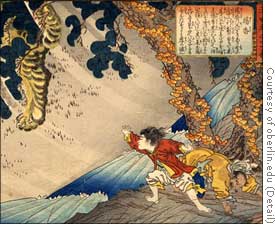
| << Front page | Arts | September 23, 2005 |
Japanese exhibit leaves imprint on its patrons
 |
||
| Kuniyoshi (detail): This woodblock print shows a young boy protecting his father from a tiger. | ||
For travel abroad without leaving campus, the most recent Allen Memorial Art Museum exhibition, Visions of Turmoil and Tranquility: Japanese Woodblock Prints from the Collection, offers a great opportunity. It is a world away from the Western Venuses and Madonnas, but is brilliant in its own right.
There are prints from the Edo period of Japan (1615-1868), the time of Ukiyo, or “the floating world,” a golden age of isolationism in Japanese history in which a rich, pleasure-seeking middle class prospered. The early ukiyo-e were cut from one block and hand-painted. For the most part, the ukiyo-e prints are portraits — a non-stop catalogue of everyone who was anyone in the 18th century. These include the courtesans, the geisha and the kabuki actors.
It was only beginning in the 1800s, faced with government censorship and new exposure to the West, that the ukiyo-e tradition shifted toward landscapes.
There are also a large number of wonderfully bizarre images. These include subjects such as “The Pilot Yoshibei Leaps into the Chopping Block Shoals and Sacrifices Himself to Save his Ship Off the Coast of Buze Province,” an 1850 print by the master Kuniyoshi, and “Woman Throwing a Snowball at a Girl Reading a Love Letter,” a late 1760s piece by Suzuki Harunobu.
In both prints, the surrounding environment is equally calm and disconcerting, and hovers seemingly in mid-air between violence and play. Just as the graceful hand of the woman is raised, so is the pilot, suspended in his flight — the fine cloth of the sails against the fine swirl of the water and the hard rings of rock.
Following the tradition from its black-and-white days when everything was cut from one block and hand-painted, the art displayed in the exhibition gives simultaneously a sense of stylistic and cultural history, a brief introduction to methods and techniques and a sense of the artists themselves.
The exhibit displays works by masters such as Harunobu, who introduced color printing, and Kuniyashi, the Japanese equivalent of Goya, as well as works from Hiroshige and Hokusai. Despite this abundance, the show is not held down by the requisite views of Mt. Fuji. The prints retain a sense of play and wonder throughout.
The last works of the exhibit, from the iconic series of the artist Hiroshige, have grown almost overripe in their colors; the evening greens of “Tea House at the Promontory of the Moon Near Takanawa” are all acidic with a deep sugary blue sky.
Hiroshige thought of his prints as basically very classy travel advertisements. Almost scientific in their serenity, they are considered to be the original picture postcards. The artist, however, rarely left his home in Edo, not even to travel to those places he so unabashedly and bewitchingly advertised.
In this way, even the most literal landscape prints in the exhibit have the feel not so much of a place to which one cannot return, but of a separate, untouched universe waiting to be explored. For example, the foreground of “Tea House at the Promontory of the Moon Near Takanawa” shows the shadow of a woman standing illuminated behind a screen, hidden except for one violent detail — the very edge of her kimono spilling over into the light.
Exhibition curators include Allen Museum director Stephanie Wiles, junior Miki Kawasaki and senior James Keary.
The new Allen exhibit has a great deal to offer to the Oberlin community, not only because of its selection and appearance, but also because of the sense of history that viewers gain in its presence.
Allen Memorial, Ripin Print Gallery Sept. 17-Dec. 23, 2005
About us
Subscriptions
Advertising